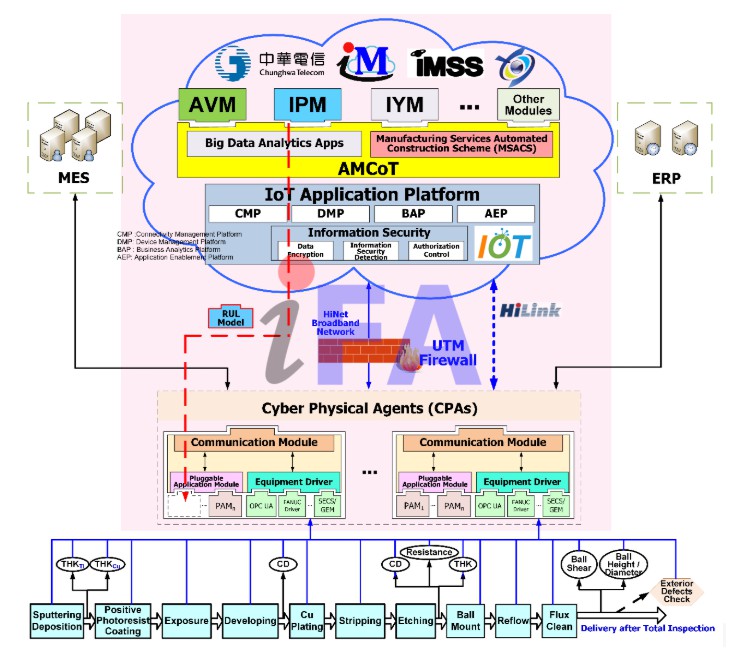Press Release
iFA for Industry 4.1
The current Industry 4.0 related technologies emphasize productivity improvement but not quality enhancement; in other words, they can only keep the faith of achieving nearly Zero Defects (ZD) state without realizing this goal. The key reason for this inability is the lack of an affordable online and real-time TOTAL-INSPECTION technology. By adopting the developed Automatic Virtual Metrology (AVM), ZD can be achieved as AVM can provide the TOTAL INSPECTION data of all products online and in real time. Further, the developed Intelligent Yield Management (IYM) can be utilized to identify the root causes of the defects for continuous improvement of those defective products; as such, nearly ZD of all products can be achieved.
The novel Intelligent Factory Automation (iFA) System Platform was developed by integrating technologies such as Cyber-Physical Agent (CPA), Advanced Manufacturing Cloud of Things (AMCoT), Automatic Virtual Metrology (AVM), Intelligent Predictive Maintenance (IPM), and Intelligent Yield Management (IYM), etc., so as to provide a total-solution package for implementing Intelligent Manufacturing. The iFA System serves as a game changer for both high-tech (e.g., semiconductor, flat panel display, solar cell, etc.) and traditional (e.g., machine tool, aerospace, carbon fiber, etc.) industries to upgrade Industry 4.0 to Industry 4.1 in pursuit of increasing productivity as well as realizing the goal of ZD of all products.
-----------------------------------------------------------------------------------------------------------------------------------------------
There are two options of the iFA System Platform for the customers to choose from: the “Server-based version” and the “Cloud-based version” are provided according to different customer requirements. The content of the two versions is illustrated in the following sections.
1. The Server-based iFA System Platform
For companies with strong capital or low demand of the cloud, a buyout Server-based version of the iFA Platform as shown in Figure 1 is recommended. The Internet of Things (IoT) technology is utilized to develop a CPA at the machine side. CPA is equipped with various Equipment Drivers for different industries, such as SECS/GEM and Interface A for the semiconductor industry, OPC-UA and MT-Connect for the machine-tool industry, etc. The Communication Module in CPA is for connecting the Internet and the cloud. Various intelligent services can be implemented as Pluggable Application Modules (PAMs) and plugged into CPA for edge computing. Then, a Big Data Analytics Applications (BDAA) platform is constructed to include various intelligent manufacturing functions such as AVM, IPM, IYM, Tool Life Management (TLM), Equipment Management System (EMS), etc. AVM can convert offline sampling inspection with metrology delay into online and real-time TOTAL INSPECTION of all the workpieces; IPM can monitor the health status of a key device and predict its remaining useful life (RUL); IYM is used to quickly identify the root causes that affect the yield; TLM is for online monitoring of cutting-tool status and providing proper tool-change time; and EMS monitors machine utilization and Overall Equipment Effectiveness (OEE).

Fig. 1. Server-based iFA System Platform
2. Cloud-based iFA System Platform
An on-demand service subscription is a better solution for many small and medium-sized enterprises whose capital is not enough to compete with large consortia to economically adopt the iFA System. As long as the companies configure their own Internet environment, they can save the high cost of building a data center on their own by just subscribing to the iFA cloud-based services with a relatively low monthly fee. They can access the various intelligent manufacturing services of iFA established on one of the commercialized data centers, such as the Chunghwa Telecom Cloud Data Center.
The Cloud-based iFA System is shown in Figure 2. CPA is equipped with different equipment drivers for various industries, such as SECS/GEM and Interface A for the semiconductor industry, OPC-UA and MT-Connect for the machine-tool industry, etc. The Communication Module in CPA is for connecting the Internet and the cloud. Various intelligent services can be implemented as PAMs and plugged into CPA for edge computing. Based on the IoT Application Platform, which is supported by Chunghwa Telecom, the Advanced Manufacturing Cloud of Things (AMCoT) framework, which includes the BDAA platform and Manufacturing Services Automated Construction Scheme (MSACS) is built. Along with the Security Services and Unified Threat Management provided by Chunghwa Telecom, abnormal activities and external hacking attacks can be prevented to ensure the overall security of the Cloud-based iFA System with the data in confidentiality. The AVM, IPM, IYM, TLM, EMS services can then be added to the AMCoT framework and constructed on the Chunghwa Telecom IoT Application Platform. All the services mentioned above can be made into intelligent cloud services that enable customers around the world to subscribe on-demand and bring a new business model to the enterprises.

Fig. 2. Cloud-based iFA System Platform.
The Cloud-based iFA System can provide the intelligence capabilities of improving manufacturing productivity as well as enhancing product quality, and preventing unscheduled down time of the production machines as well as reducing the maintenance cost of the machines. As such, the goal of nearly ZD of all produced products can be achieved efficiently and economically. This is the state of the so-called Industry 4.1 that the authors defined where the competitiveness and benefits of manufacturing industries can be greatly enhanced.
To sum up the functions described above, the main features and benefits of the iFA System include:
Accomplishing Big-Data-Collection Infrastructure
[w/ CPA – Internet of Things and Edge Computing]
Accomplishing Cloud-Computing Infrastructure
[w/ AMCoT – Cloud Manufacturing]
Establishing Internet security and monitoring system
[w/ IoT Security Operation System – Information Security]
Accomplishing Workpieces Total Quality Inspection
[w/ AVM – Total Quality Inspection for Achieving Zero Defects]
Improving Production-Tools’ Availability
[w/ IPM – RUL Prediction Preventing Unscheduled Down]
Constructing Root-Causes Searching Infrastructure of Yield Loss
[w/ IYM – Root-Causes Identification of Yield Loss for Continuous Improvement]
Real-time monitoring of the Cutting-Tool status and providing adequate timing for tool replacement
[w/TLM – RUL Prediction of the Cutting-Tool status]
Managing the Utilization of the factory and monitoring the Overall Equipment Effectiveness (OEE)
[w/ EMS – Equipment Management System]
